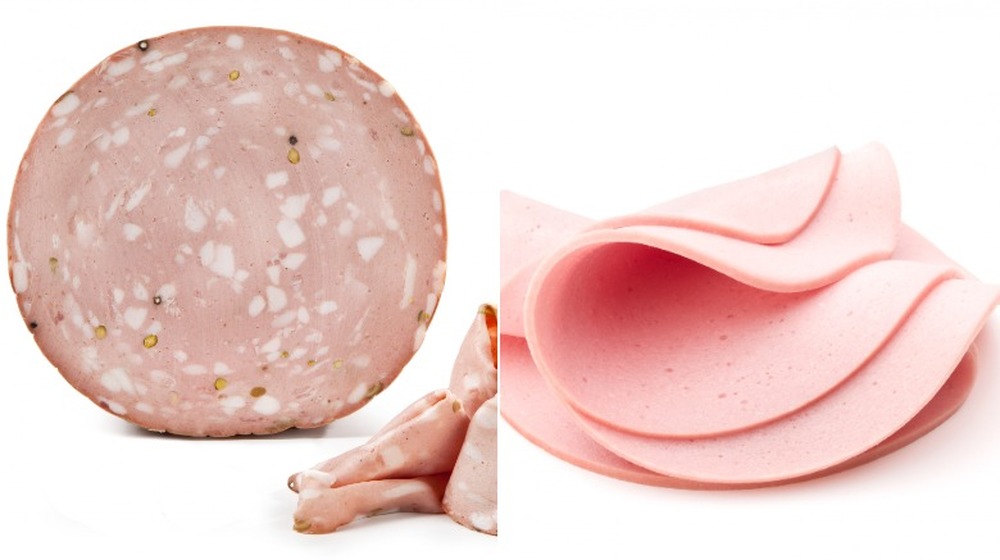This Is Why Bologna Is So Cheap
Pink circles of meat, slathered with mayo, nestled between slices of soft Wonder bread — it's an iconic (or unappetizing) image, depending on your preferences. And that timeless sandwich can be constructed for around 34 cents, which made it the most economical sandwich of 2020 (via LenPenzo.com).
One of the main components of it happens to be one of America's favorite sandwich stuffers: bologna. Although it was named after the Italian city of Bologna, it's actually quite different from what the Italians had in mind. The Italian version, known as mortadella, is a cured sausage made from pork and lard, spiced with black pepper and studded with pistachios (via New York Style Deli). In fact, the name "mortadella" comes from the mortar and pestle used to grind bits of pistachio and myrtle berries into the meat (via USA Today).
The Italians revere the meat so much that, in 1661 the Pope gave it a legal definition: A subtly seasoned delicacy made of lean pork speckled with lumps of lard (via Eater). Currently, it's protected by the European Union, which grants mortadella bologna the Protected Geographical Indication, meaning companies bearing the label must follow a precise formula for producing the product (via Italian Food Excellence).
Mortadella has a pretty incredible history, too. According to Vice, the cured sausage fed the Roman army, employed 10,000 townspeople in the Middle Ages (one quarter of the city's population), compelled Napoleon to bring it back to France, fed Buffalo Bill during his time in Bologna, and coerced Sophia Loren's character to smuggle it past U.S. customs in the 1971 film "La Mortadella."
Bologna completely changed when it hit the states
When mortadella hit U.S. soil in the late 19th century, Americans revamped the recipe and created bologna, made with beef, chicken, pork, or some combination of the three. Some varieties contained premium cuts, while others were made from ground-up parts and trimmings.
Affordable and flavorful, sure — but what are we actually eating? It all depends on the brand. Choose premium bologna like that from Boar's Head, and you'll get hand-trimmed cuts of beef and "carefully selected spices" for around $8 per pound (via Kroger). Switch to the stuff sold in plastic containers, and it's closer to $2.50 per pound. Why the plunge in price? In the case of the cheaper version, it seems that, because mechanically separated chicken is the first ingredient, and not beef, its price plummets (via Oscar Mayer).
What's mechanically separated chicken? The National Chicken Council suggests that we imagine a rotisserie chicken, but not the whole bird, just what's left after you rip off the breasts, wings, legs, and thighs; essentially the meat scraps clinging to the bone. The USDA further explains that the bones and skeletal muscles are crushed and forced through a sieve to create soft tissue with a cake-batter consistency.
That's the stuff used to make bologna, which explains the price. You can clearly craft that sandwich for less than a buck, but do you want to?
Will the future still consider bologna a cheap meat?
Eater adds that in the past, bologna was made from discarded or fatty meat parts — even organ meat in some cases — so it was cheaper than ham or salami, making it more accessible and popular during the Great Depression. USA Today further notes that, as bologna's popularity spread, some began to view the meat as "unclean food for the poor." Even beyond the Great Depression, bologna's role in American history continued to be an inexpensive meat sometimes used by the government when needing to serve large sectors of people. Such groups included migrant workers in the mid-20th century, many who turned to food pantries or soup kitchens for food, and it's even used for meals for those incarcerated in the country's prisons. When the economy hit a low in 2009, restaurants brought back bologna sandwiches as a way to defray costs, adds Eater.
Fast forward a few years and many butchers and restaurateurs alike are trying to rehabilitate bologna's reputation as a 'cheap' meat. In 2014, Chef David Chang spoke to GQ about artisan bolognas, claiming his restaurant then served one dish made from duck bologna seasoned with Chinese spices. One meat processing company, Peachey Foods, based in Pennsylvania, produces custom bologna in a variety of flavors including teriyaki and honey barbecue, still at reasonable prices. Eater also notes some restaurants have even started including bologna on their charcuterie boards. Will bologna eventually be transformed from a cheap cafeteria staple to a delicacy? Only time will tell.


